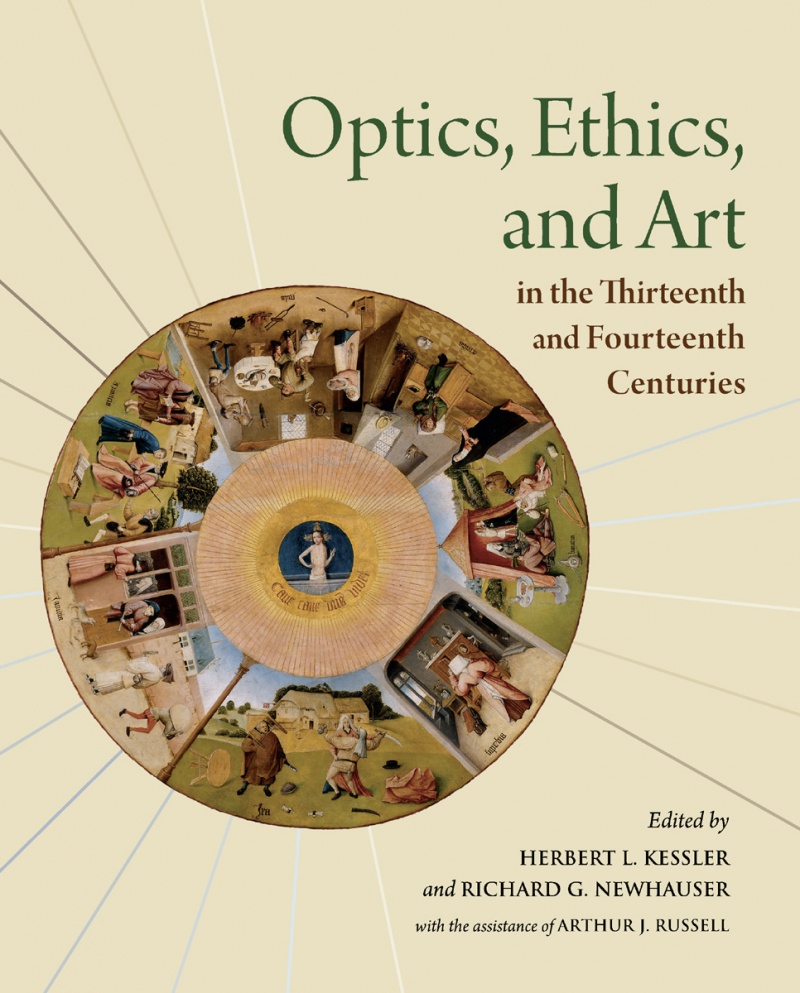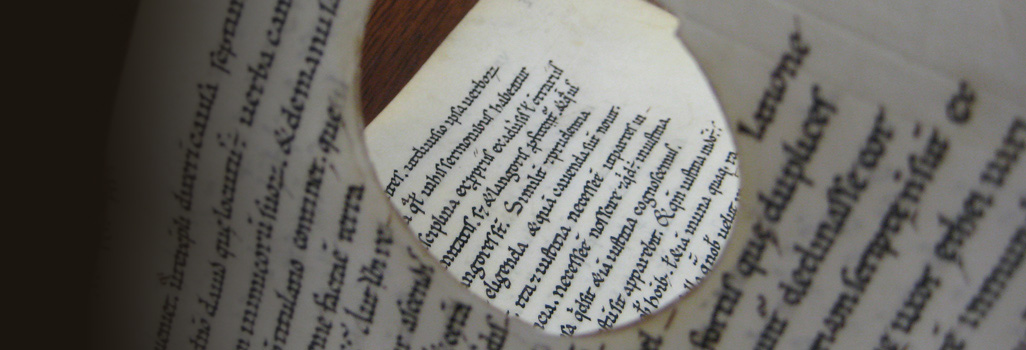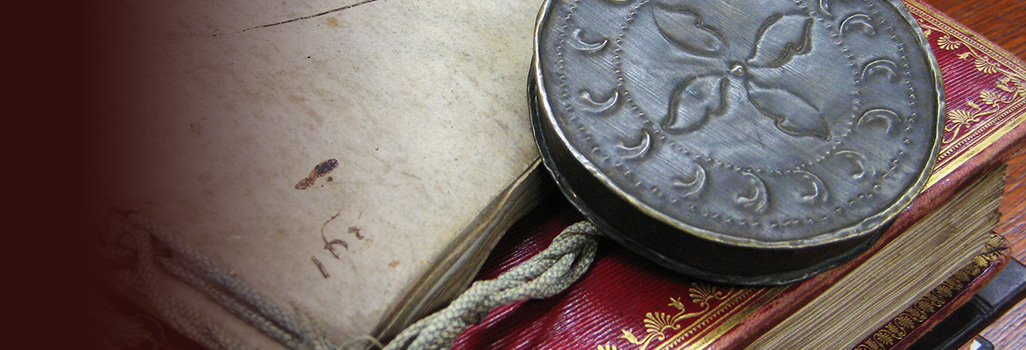
Optics, Ethics, and Art in the Thirteenth and Fourteenth Centuries: Looking into Peter of Limoges’s Moral Treatise on the Eye
with the assistance of Arthur J. Russell
Studies and Texts 209; Text Image Context: Studies in Medieval Manuscript Illumination 5. 2018. xiv + 212 pp. ISBN 978-0-88844-209-3 • Cloth • $95
This volume examines afresh the various ways in which the introduction of ancient and Arabic optical theories transformed thirteenth-century thinking about vision, how scientific learning came to be reconciled with theological speculation, and what effect the results of these new developments had on those who learned about them through preaching.
The contributions underscore the fact that Greek optical science was known earlier than has been often assumed, and also emphasize the ways in which Christian theories of vision had long included those in which light was a metaphor for God and in which looking at an object in a straight line of sight might be reckoned as just, while oblique vision could be understood as corrupt. Physiological vision always involved interference and, hence, implicated ethics and morality. Governed by a knowledge of Scripture, edified by exempla, and perfected through scrutiny, the results of perception had the potential to elevate the material world onto a more spiritual plane.
At the core of this collection of essays lies Peter of Limoges’s Tractatus moralis de oculo, a compilation designed for the preparation of sermons that drew creatively on the best-known theorists of optical science in late thirteenth-century Paris. The work is remarkable not only for subsuming science into the edifice of theology, but also for glossing the physiology of the eye and theories of perception in terms of Christian ethics and moralization, thereby making esoteric learning accessible to the public (including artists) through preaching. Transgressing traditional boundaries between art history, science, literature, and the history of religion, the book's nine essays complicate the generally accepted understanding of the impact science had on thirteenth-century visual culture.
Editors
Herbert L. Kessler is Professor Emeritus of the History of Art at Johns Hopkins University and Invited Professor of the Masaryk University, Brno. An elected Fellow of the American Academy of Arts and Sciences and of the Medieval Academy of America, he has published some 200 articles and reviews and is author or editor of twenty-four books. His recent publications include (with Paul E. Dutton) The Poetry and Paintings in the First Bible of Charles the Bald (1997); (with Johanna Zacharias) Rome 1300: On the Path of the Pilgrim (2000); Seeing Medieval Art (2004); and Neither God nor Man: Texts, Pictures, and the Anxiety of Medieval Art (2007).
Richard G. Newhauser is Professor of English and Medieval Studies at Arizona State University, Tempe. He has been awarded fellowships by the Guggenheim Foundation, the NEH, ACLS, and the National Humanities Center. He has published extensively on the moral tradition and sensory studies in the Middle Ages and beyond and is the author or editor of fifteen books, including Sin: Essays on the Moral Tradition in the Western Middle Ages (2007); (co-editor) Sin in Medieval and Early Modern Culture (2012); (translator) Peter of Limoges, The Moral Treatise on the Eye (2012); and (editor) A Cultural History of the Senses in the Middle Ages (2014). He is completing a critical edition of Peter of Limoges’s Tractatus moralis de oculo.
Arthur J. Russell is Lecturer in the Department of English at Case Western Reserve University. He recently completed his dissertation at Arizona State University on “The Moral Sense of Touch: Tactile Values in Late Medieval England.” His publications include (co-author) “Mapping Virtual Pilgrimage in an Early Fifteenth-Century Arma Christi Roll,” in Arma Christi (2014). He is preparing a fascicle on the Huntington Library for An Index of Images in English Manuscripts from the Time of Chaucer to Henry VIII.
Contents
List of Figures • ix
Contributors • xii
Abbreviations • xiv
Herbert L. Kessler and Richard G. Newhauser • Introduction • 1
Richard G. Newhauser • Morals, Science, and the Edification of the Senses • 7
Carolyn Muessig • “Can’t take my eyes off of you”: Mutual Gazing Between the Divine and Humanity in Late Medieval Preaching • 17
Donal Cooper • Preaching amidst Pictures: Visual Contexts for Sermons in Late Medieval Tuscany • 29
Aden Kumler • Seeing the Worldly with a Moral Eye: Illuminated Observation as Introspection • 47
Jacques Berlioz • Eyes in the Back of the Head: Exempla and Vision in The Moral Treatise on the Eye by Peter of Limoges • 65
Larry Scanlon • Is the Exemplum a Mirror? • 85
A. Mark Smith • Skating on Thin Eyes: Hans Belting on the Optics of Arabic and Western Art • 103
Christopher R. Lakey • “To See Clearly” – The Place of Relief in Medieval Visual Culture • 119
Herbert L. Kessler • Fenestra obliqua: Art and Peter of Limoges’s Modes of Seeing • 139
Notes • 159
Bibliography: Manuscripts, Primary Sources, Secondary Texts • 190
Illustration Credits • 206
Index • 208
Endorsements
“A volume about what Foucault would have called disciplining the senses, but here is better characterized as edifying the eye or the senses, this compendium of art and intellectual history charts new paths into the fascinating and fecund later Middle Ages. The goal of the volume is to interrogate afresh how ancient and Arabic optical theories transformed later medieval thinking about vision, how scientific learning came to be reconciled with theological speculation, and what effect these results had on those who learned about them through preaching.” — Robert Nelson, Yale University
Ordering
Customers in North America please order through University of Toronto Press Distribution by phone (1-800-565-9523) or by email (utpbooks@utpress.utoronto.ca). If you would like to order through UTP Distribution using another method such as mail or fax, please click here for a full list of contact and ordering methods. PIMS books are also available on Amazon.ca (for Canadian customers) and Amazon.com (for customers in the U.S.).
Customers outside North America please order through Brepols Publishers. PIMS books are available through the Brepols online catalogue.


